Modern Vocal Score Dynamics
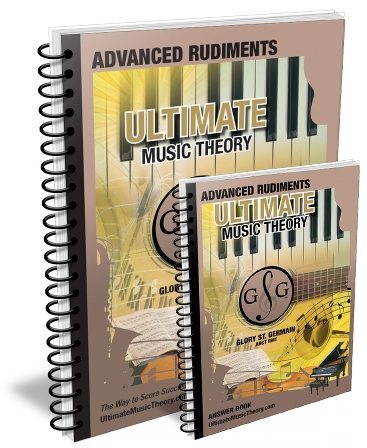
Modern Vocal Score Dynamics
In Advanced Rudiments, students are introduced to Modern Vocal Score (Page 113). Each year, I receive a number of emails from Teachers and Students who just want clarification where Modern Vocal Score Dynamics are placed.
Modern Vocal Score Dynamics have specific placement positions as they are intended to be followed by the vocalist.
So here are some Ultimate Music Theory Tips to remember how to write Modern Vocal Score Dynamics - with and without lyrics - in Open and in Short Score.
Modern Vocal Score - Open Score
Modern Vocal Score is written for four voices - Soprano, Alto, Tenor and Bass.
Open Score is also called Full Score. Open Score is written using 4 staves - each voice has its own staff. Starting at the top (with the highest voice) and going down (to the lowest voice):
- The Soprano is written in the Treble Staff
- The Alto is written in the Treble Staff
- The Tenor is written in the Treble Staff with an "8" underneath (to indicate that it is written one octave higher than it sounds)
- The Bass is written in the Bass Staff
My students remember the required Clefs using this funny saying "In Vocal Score, you have Treble, Treble, Treble ate the Bass" (Treble, Treble, Treble 8, Bass). Okay - so it's not that funny...but it helps them remember the Clefs!
Modern Vocal Score Dynamics - With Lyrics - Open Score
In Open Score for Modern Vocal Score, lyrics (the words) are written below each staff line. The lyrics will line up with the melody and rhythm of the voice that is singing them.
When there are lyrics included in the Score, the Modern Vocal Score Bar Lines are written on each individual staff (and not completely through the Open Score). This allows for the words to be read (sung) without being hindered by the bar lines.
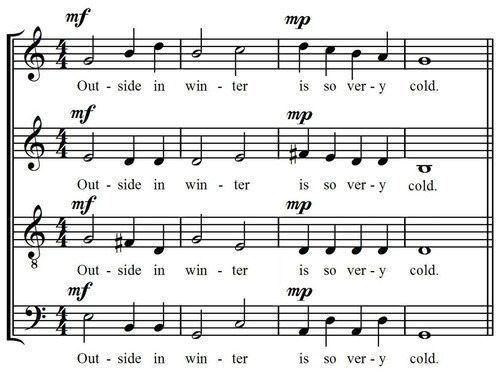
Modern Vocal Score Dynamics should be written above each staff in Open Score. The vocalist must follow the dynamics above the staff and read the lyrics below the staff.
Modern Vocal Score Dynamics - Without Lyrics - Open Score
Option #1: (Recommended) When words (lyrics) are not included in an excerpt of Modern Vocal Score, it is still preferred that the dynamics be written above each staff.
Option #2: (Acceptable) However, it is "acceptable" for them to be written below each staff. (A student would not be deducted marks on an examination for placing them below each staff.)
Modern Vocal Score Dynamics - Short Score
Short Score is also known as Keyboard Score, Condensed Score and Close Score. In Short Score, there are only 2 staves - the Treble Staff (on top) and the Bass Staff (on bottom).
- The notes for the Soprano Voice are written stems up in the Treble Staff.
- The notes for the Alto Voice are written stems down in the Treble Staff.
- The notes for the Tenor Voice are written stems up in the Bass Staff.
- The notes for the Bass Voice are written stems down in the Bass Staff.
In Short Score, the lyrics are written in the middle of the Grand Staff. Modern Vocal Score Bar Lines are written through each individual staff (and not completely through the Grand Staff).
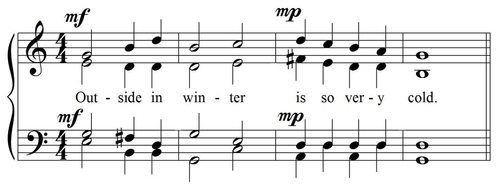
Dynamics are written above the Treble Staff for the Soprano and Alto Voices, and above the Bass Staff for the Tenor and Bass Voices.
Modern Vocal Score Dynamics - Short Score - No Lyrics Included
There are times when words (lyrics) are not included in an excerpt of Modern Vocal Score. Remember that there are 2 options for Bar Lines in Short Score without Lyrics:
Option #1: (Recommended) The Modern Vocal Score Bar Lines are written on each individual staff.
Option #2: (Acceptable) The Modern Vocal Score Bar Lines are written from the top of the Treble Staff straight through to the bottom line of the Bass Staff.
Be consistent though - if there will be lyrics eventually in your music, write the Bar Lines on each individual staff throughout the composition (even when there are no lyrics).
There are 2 options for the Dynamics in Short Score without Lyrics:
Option #1: (Recommended) Dynamics are written above the Treble Staff for the Soprano and Alto Voices, and above the Bass Staff for the Tenor and Bass Voices.
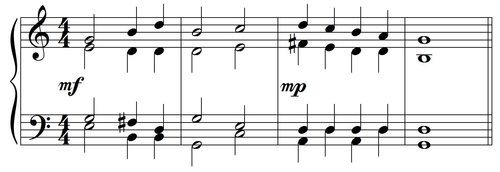
Option #2: (Acceptable - as shown in the above example) Dynamics are written in the middle of the Grand Staff.
- LEARN FASTER – Use on any device, phone, tablet, computer
- EXPLORE – Identify written & audio notation
- PLAY – Sight Reading and Ear Training Games and much More!
Students will LOVE hearing exact pitch and pronunciation of terms.
Students will be INSPIRED to use their imagination while building a foundation in Ear Training and Sight Reading.
The One and ONLY Music Theory App & Matching Workbook!
Keep on Learning... With a Smile and a Song!
Shelagh McKibbon-U'Ren
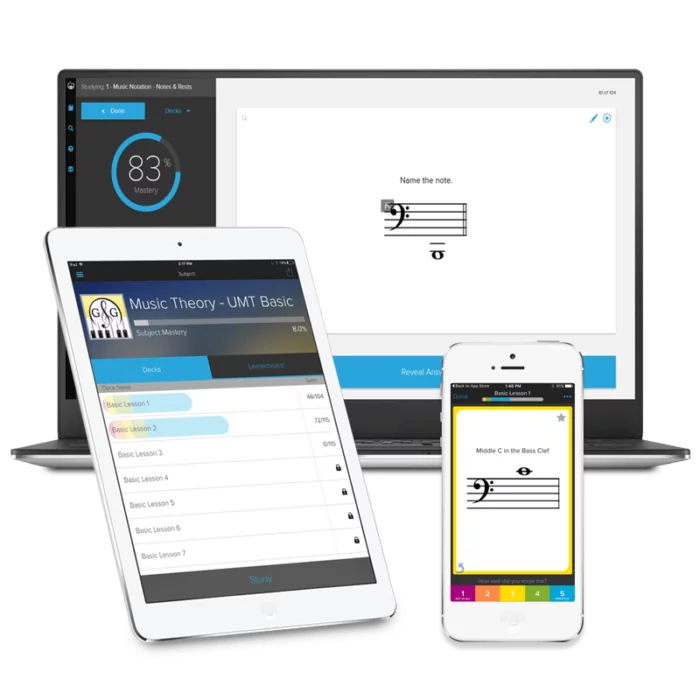


This is helpful. Question: When you have several expression markings (e.g., dynamics, “Soprano solo,” and “with great expression”), Is there a old guideline or rule of thumb to use regarding placement?
Great question George. My rule of thumb is, where would you put it if the staff was all by itself? That is where you can put it when their is more than one staff. However, if it doesn’t “fit”, then put it where you can.
Thanks so much for this, just what I was looking for. Question if you have a chance to answer: for a piece of music that is voice and piano accompaniment, do you need to place dynamics in the voice part? It looks like a lot of scores put them only in the piano unless the voice does something different than the accompaniment. Don’t want to be redundant, but that seems hard for a vocalist since it’s way below what they’re reading. Thanks again.
What a fabulous question. According to The Norton Manual of Music Notation, the dynamic markings for the vocal part should be written ABOVE the Staff for the voice part. (So, words underneath/below and dynamics above.) This keeps the dynamics from crushing into the vocal text, and hopefully as the singer follows the melody line, they will see those dynamics out of the top of their “eyes”.
Shelagh